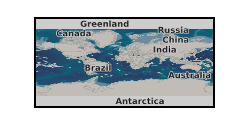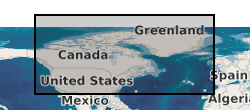Glaciation
Type of resources
Topics
Keywords
Contact for the resource
Provided by
Years
Formats
Representation types
Update frequencies
-

Revised full proposal for scientific drilling (852-CPP2) 'GlaciStore: Understanding Pleistocene glaciation and basin processes and their impact on fluid migration pathways (North Sea)', submitted to Integrated Ocean Discovery Programme (IODP) April 2016. The proponent 'GlaciStore' consortium comprises research and industry organisations from the UK, Norway, USA and Canada. The full proposal describes the relationship of the proposed research with the IODP science plan, sets the regional background and describes and illustrates three scientific objectives. The objectives are to: establish a high-resolution depositional and chronological framework defining multiple cycles of glacial advance and retreat over the last 2.6 Ma by investigating the strata preserved in the centre of the NSB by scientific drilling, sampling and detailed analysis; investigate how the temporal variations in depositional environment and geochemistry of the different stratigraphic units have affected the pore fluids (dissolved gases, salts and isotopes) and the microbial community; determine the measurable impact on geomechanical properties of strata (porosity, rock stiffness, in-situ stresses, pore pressure, fractures) caused by cycles of glacial loading and unloading. The drilling and sampling strategy, standard drilling and logging operations and the specialist measurements expected to be taken are described. Related initiatives and wider context of the proposed research also the initial and planned strategy for support from industry and government are outlined. The lead submitter, on behalf to the GlaciStore consortium is Heather Stewart, British Geological Survey (BGS).The 32 proponents from the UK and Norway (BGS, Institute for Energy Technology, Lundin Norway AS, Memorial University of Newfoundland, SINTEF Energy Research, Statoil ASA, University of Bergen, University of Edinburgh University of Oslo, University of Texas at Austin and University of Ottowa) and their expertise are listed and detailed. Site forms for each of the 13 proposed drilling sites are included.The full proposal is a pdf format file. This is restricted to the proponents for publication and to progress to a revised full proposal accepted for drilling by IODP. UKCCSRC Grant UKCCSRC-C1-30.
-

Numerical model predictions of present-day solid Earth deformation and gravity field change due to ongoing glacial isostatic adjustment processes. Model accounts for 3D spatial variations in Earth rheology using a finite element approach.
-

Numerical model predictions of present-day horizontal deformation due to ongoing glacial isostatic adjustment processes at GPS sites across Antarctica. Model accounts for 3D spatial variations in Earth rheology using a finite element approach.
-

Data generated using freely-available satellite remote sensing observations from the USGS Earth Resources Observation Science Centre, together with a freely-available ice margin chronology from Dyke et al. (2003) Geological Survey of Canada Open File Report No. 1574. The map is published in the Journal of Maps: http://www.tandfonline.com/doi/full/10.1080/17445647.2014.912036 Published article in 'Nature' Volume 530 Feb 2016 with associated source data. https://dx.doi.org/10.1038/nature16947 Published paper in the Taylor Francis Online Journal with associated data. https://dx.doi.org/10.1080/17445647.2014.912036
-

This image dataset was captured as part of the operation of an automated weather station at the Virkisjökull-Falljökull Glacier, SE Iceland. The station formed part of the BGS Iceland Glacier Observatory network of sensors, deployed between 2009 and 2020 in order to characterise and identify glacial, geomorphological and hydrological drivers and processes and their timescales across the deglaciating Virkisjökull-Falljökull catchment in SE Iceland. This image time series was generated alongside the continuous operation of two further weather stations, river gauging, a network of groundwater level gauges and numerous other forms of monitoring. The records presented here begin in September 2011 with the installation of the camera on the weather station, and continue to December 2019. The data complements the published groundwater and river gauging datasets published here, and will be of use to researchers, teachers and students wishing to see an excellent example of glacier flow, or those interested in the processes observed in a rapidly deglaciating landscape, including anyone interested to follow up on the various research studies published from this site in the international literature. The BGS project was led and coordinated by Dr Jez Everest, and during earlier years Tom Bradwell (Uni of Stirling, formerly BGS). Technical support and implementation was provided by Heiko Buxel and Tom Shanahan. The dataset is not fully continuous as certain periods were lost due to equipment downtime. Enquiries are welcome and should be directed to Dr Everest.
-

This image dataset was captured as part of the operation of an automated weather station at the Virkisjökull-Falljökull Glacier, SE Iceland. The station formed part of the BGS Iceland Glacier Observatory network of sensors, deployed between 2009 and 2020 in order to characterise and identify glacial, geomorphological and hydrological drivers and processes and their timescales across the deglaciating Virkisjökull-Falljökull catchment in SE Iceland. This image time series was captured at (WGS-84) 63°58’12.78?N 16°47’5.64?W, on a lateral moraine sequence adjacent to the glacier icefall and were generated alongside the continuous operation of two further weather stations, river gauging, a network of groundwater level gauges and numerous other forms of monitoring. The records presented here begin in September 2011 with the installation of the camera on the weather station, and continue to February 2018. The data complements the published groundwater and river gauging datasets published here, and will be of use to researchers, teachers and students wishing to see an excellent example of glacier flow, or those interested in the processes observed in a rapidly deglaciating landscape, including anyone interested to follow up on the various research studies published from this site in the international literature. The BGS project was led and coordinated by Dr Jez Everest, and during earlier years Tom Bradwell (Uni of Stirling, formerly BGS). Technical support and implementation was provided by Heiko Buxel and Tom Shanahan. The dataset is not fully continuous as certain periods were lost due to equipment downtime. Enquiries are welcome and should be directed to Dr Everest.
 NERC Data Catalogue Service
NERC Data Catalogue Service